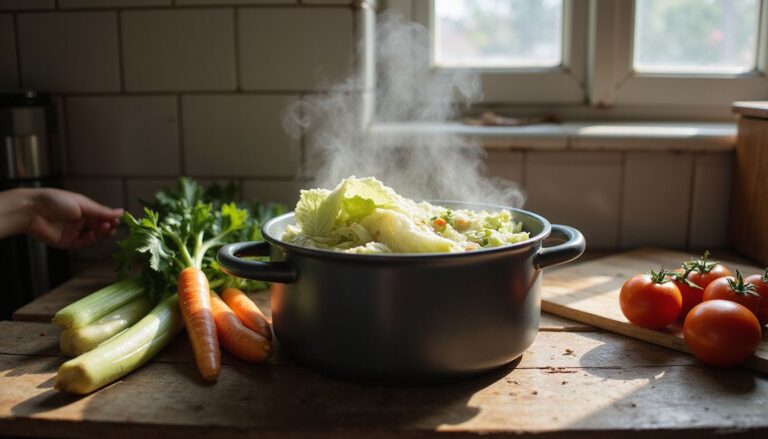Juicing For Weight Loss: Best Juice Recipes And Cleanses
Our Nutrition Assistant AI Suite will transform your body. You will lose fat, get toned, and build muscle. Gain confidence and optimal health.
You may be trying to lose weight or looking for healthier drinks that fit your day. Juicing for weight loss uses fresh fruit and vegetable juices to raise vitamin and mineral intake while keeping calories in check. Used well, it can support a balanced diet and make healthy eating feel easier.
This guide covers how juicing works, the health benefits, and simple juice recipes that can support weight management. Explore clear tips and delicious recipes to kick-start your plan.
Key Takeaways
- Juicing boosts vitamins and minerals but removes most fiber. Blend whole produce or add seeds to improve nutrition and fullness.
- Research suggests juices like watermelon, about 2 cups or 300 grams daily, can reduce body weight and belly fat in four weeks.
- Juice cleanses lead to quick, short-term weight loss from calorie restriction. Studies from 2021 do not show lasting fat loss or detox effects.
- Mayo Clinic experts note that pure fruit juice can spike blood sugar, especially for people with diabetes. Choose mostly vegetable-based blends.
- Registered dietitians suggest using fresh homemade juices as part of a balanced diet with protein, fiber-rich foods, and regular exercise for long-term weight management.

What Are the Basics of Juicing?

Juicing extracts liquid from fruits and vegetables and leaves behind most of the fiber-rich pulp. The juice delivers vitamins, minerals, and antioxidants, which are compounds that help protect your cells.
Many people prefer homemade juices because store-bought fruit juice can be high in sugar or contain preservatives. You can compost the leftover pulp or use it in baking to reduce food waste.
Making juice at home gives you full control of ingredients. That supports a balanced diet and helps you limit added sugars common in commercial products. Juicing became popular in the 1990s as people chased detox claims and fast weight loss.
Studies suggest fresh juice can raise nutrient intake, yet it removes dietary fiber, which helps digestion and steady blood sugar. Health sources like Mayo Clinic advise people with diabetes to limit pure fruit juice because it may cause rapid blood sugar spikes.
Juicing pulls out nutrients fast but leaves behind nearly all fiber—think clear apple juice instead of eating an apple.
Blending whole produce keeps both nutrients and fiber together. Smoothies can be a better pick if gut health or stable energy is your main goal. Next, see how juicing can support weight loss in practical ways.
Juicing Benefits for Effective Weight Loss
Juicing can fit into weight loss by offering low-calorie, nutrient-dense drinks. Many blends use leafy greens and colorful produce to support better health. These ideas can help you find the best juices for weight loss.
How Does Juicing Enhance Nutrient Intake?
Fresh juice packs many micronutrients, which are vitamins and minerals your body needs in small amounts. For example, 100 grams of spinach juice can provide more than 400 percent of the daily value for vitamin K, which supports blood clotting and bone health.
Orange juice is rich in vitamin C for immune support. Watermelon juice provides potassium, which helps muscles and blood pressure balance.
Spinach, kale, carrots, pineapple, celery, beetroot, and berries make excellent bases. They deliver vitamins A and C, manganese, and other minerals in an easy-to-drink form.
Scientific reviews show fresh juices can offer similar micronutrients to whole foods but far less fiber because the pulp is removed. Juicing can help you reach daily produce goals when you struggle to eat enough fruits and vegetables.
Using a variety of produce also adds flavor and prevents boredom. It is a simple way to raise plant intake without extra calories from sweetened drinks or snacks.
How Can Juicing Support Digestive Health?
Prune juice provides almost 3 grams of fiber per 8 ounces, which helps keep your system regular. Ginger contains plant compounds with antioxidant effects and may ease digestion.
Hydrating juices made with celery or cucumber add fluid, which helps your gastrointestinal tract move food along. Some produce, like apples and bananas, contains prebiotics, which are fibers that feed healthy gut bacteria.
Ginger in juices helps your digestive system and gives your body a healthy boost.
With the right ingredients, a juice can support healthy digestion as part of a balanced diet. Next, see how juicing can lower calorie intake while keeping you satisfied.
How Does Juicing Help Reduce Calorie Intake?
Juices made from low-calorie produce can help you feel full with fewer calories. Celery juice, for example, has about 33 calories per cup and is more than 95 percent water.
A study of 33 adults found that drinking two cups, about 300 grams, of watermelon daily for four weeks reduced body weight, belly fat, hunger, and cravings. Choosing lower-calorie blends can help you manage portions while still enjoying sweet, fresh flavors.
Swapping sugary drinks for vegetable-forward juices reduces added sugar and makes weight management less stressful. Over time, these small shifts add up.
How Does Juicing Improve Hydration?
Celery juice is more than 95 percent water. Cucumber juice also adds fluid plus potassium and vitamin K.
Watermelon juice stands out because it delivers high water content with a light, sweet taste. Many people find it easier to drink hydrating juices than plain water, especially in hot weather or after workouts.
Replacing soda with watermelon mint juice helped me curb cravings and keep my blood sugar steadier during a weight loss phase. Hydration supports energy, mood, and daily activity.
What Energizing Benefits Does Juicing Provide?
Fresh juices can supply vitamins and plant nutrients that your body uses for energy. Beetroot juice contains dietary nitrates, which may improve endurance during exercise.
Carrot juice is rich in carotenoids like beta-carotene, which your body turns into vitamin A for vision and immune support. Ginger may boost metabolism and reduce appetite swings, which helps prevent energy crashes.
Antioxidants from leafy greens, berries, and citrus may reduce inflammation and support circulation. A mix of produce gives you a broader range of helpful plant compounds. Keep the blend balanced to get steady energy without extra sugar.
Key Considerations for Juicing
Planning matters. Smart choices help you enjoy great flavor and steady progress without common missteps.
How to Maintain Dietary Balance While Juicing?
Keep juices inside a well-balanced diet built on whole foods. Seeds, beans, whole grains, dairy or yogurt, and nuts provide protein and fiber that juices lack.
Dietitians with the Academy of Nutrition and Dietetics recommend using juice as an add-on, not as a full meal, to avoid hunger and nutrient gaps. Choose 100 percent juices with no added sugar to support blood sugar control and weight management.
Boost staying power by blending oats or chia seeds into smoothies, or add a scoop of protein powder. Pair a small glass of juice with meals rich in fiber and healthy fats, like salmon and quinoa, to round out nutrition.
Which Fruits and Vegetables Are Best for Juicing?
Select produce that supports immunity, digestion, and weight control. These options make strong building blocks:
- Kale is low in calories and rich in nutrients. It supports immune health and healthy blood pressure.
- Carrots contain beta-carotene and other carotenoids for vision and immune support. They also sweeten blends.
- Apples offer prebiotic fiber that feeds gut bacteria and add gentle sweetness.
- Berries such as strawberries and raspberries provide antioxidants that may support blood sugar control.
- Beetroot supplies nitrates that may benefit heart health and exercise performance.
- Pineapple adds manganese for bone health and metabolism with a tropical taste.
- Celery brings hydration and potassium, helpful for active days.
- Lemon adds vitamin C and a tart flavor without extra sugar.
- Pomegranate juice is rich in antioxidants and may reduce risks linked to chronic conditions.
- Spinach provides iron and magnesium, which support muscles alongside regular exercise.
I often combine kale and lemon in a morning juice. It keeps me satisfied and helps me skip heavy breakfast choices.
Why Avoid Sugary Juice Mixes?
Check labels on store-bought juices to avoid added sugars and syrups. Extra sugar can lead to weight gain and bigger cravings.
Soda often contains about 40 grams of sugar per serving. A similar serving of fresh watermelon juice has closer to 10 grams. Large sugar hits can spike and then crash blood sugar, which may increase hunger.
Many packaged juices use sweeteners instead of whole fruit and vegetable ingredients. That adds calories without the nutrients you expect. For better results, choose 100 percent fruit or vegetable juices or make your own at home with a blender or juicer.
Reading labels is a simple habit that protects your goals. It also helps you pick beverages that support hydration and fat loss.
How to Add Fiber and Protein to Juices?
Blending whole fruits and vegetables, instead of only juicing, raises fiber. Leafy greens like kale or spinach add bulk and nutrients.
Prune juice naturally supplies close to 3 grams of fiber per 8 ounces, which is high for a juice. You can also blend in fibrous vegetables for more texture and staying power.
Increase protein by adding chia, hemp, or ground flaxseed. A scoop of protein powder works too. These upgrades make your drink more filling and helpful for muscle health during weight loss.
Top Juice Recipes to Promote Weight Loss
These simple recipes highlight nutrient-dense ingredients, steady energy, and great taste. Use them as snacks or add-ons to meals.
How to Make a Green Juice Recipe?
This green juice supports weight loss while packing flavor and vitamins.
- Wash 100 grams of spinach leaves to remove dirt or residue before juicing. Spinach is very high in vitamin K for bones and clotting.
- Slice one green apple and remove the seeds. It adds light sweetness without a large sugar load.
- Peel a one-inch piece of fresh ginger for extra flavor and digestive support.
- Juice half a lemon for vitamin C and a bright taste.
- Add half a cup of cold water to lighten the texture and improve hydration.
- Run all ingredients through a juicer until smooth and consistent.
- Serve at once for the freshest taste and best nutrient quality. Add ice if you like it cold.
- Drink soon after making it to preserve vitamin C and other sensitive nutrients.
- Talk with a health professional if you take medication or have chronic conditions before making major diet changes.
What Is a Good Carrot and Ginger Juice Recipe?
This blend is simple and supportive for vision, immunity, and digestion.
- Wash and peel three large carrots, then slice for easier juicing.
- Add one small peeled ginger root. Ginger provides antioxidants and may calm the stomach.
- Squeeze in the juice of half a lemon for vitamin C and a bright finish.
- Pour in one cup of cold water to reduce natural sugar concentration and calories.
- Juice everything using a quality machine. Carrots deliver carotenoids that your body turns into vitamin A.
- Drink right away for best flavor and hydration.
- I often use this as a mid-morning snack. It helps me skip processed snacks.
- Many nutrition experts link these ingredients with healthy digestion and skin support, which can complement a thoughtful weight plan.
How to Prepare Apple and Kale Juice Mix?
This hydrating blend supports immune health and healthy blood pressure.
- Gather one large apple, five kale leaves, one celery stalk, half a cucumber, and one cup of water. Fresh, high-quality produce offers the best taste.
- Wash produce well to remove dirt and pesticide residue.
- Core the apple and chop it. Slice kale and celery for faster juicing.
- Add apple, kale, celery, cucumber, and water to your juicer. Feed them in gradually for even extraction.
- Juice until smooth and bright green. This mix brings vitamin K, vitamin C, potassium, and antioxidants.
- Pour into a glass right away to preserve flavor and nutrients.
- Use ice for a colder drink or add a bit more water if you prefer a lighter taste.
- Have it at breakfast or as a midday pick-me-up. I notice fewer cravings and better hydration when I use this mix.
- Watch portion sizes so total calories match your plan.
- Avoid adding sugary mixers or alcohol, which can slow weight progress and work against health goals.
What Are the Benefits of Beetroot and Berry Juice?
Beetroot provides natural nitrates that may improve exercise performance and support heart health. Studies also link beetroot juice with lower blood pressure because nitrates help blood vessels relax.
Berries such as strawberries and raspberries bring fiber and antioxidants. That combination can help with fullness and gentle blood sugar control during weight loss.
This blend delivers vitamin C, folate, and polyphenols that protect cells. A squeeze of lemon adds more vitamin C and a fresh taste. During a busy week, I used this recipe and noticed steady energy with great hydration.
Blend beetroot, strawberries, raspberries, lemon, and water for a nutrient-rich drink that supports your eating plan.
How to Make Citrus and Celery Juice Recipe?
This light juice is hydrating, low in calories, and full of flavor.
- Rinse one large orange, two celery stalks, half a cucumber, and measure one cup of cold water.
- Peel the orange and cut it into quarters. Oranges supply vitamin C for immune support.
- Slice celery and cucumber into small pieces. They add vitamin K, folate, potassium, and extra hydration.
- Add orange, celery, cucumber, and water into your juicer or blender for a refreshing, low-calorie mix.
- Blend or juice until smooth. If using a blender, strain for a thinner texture.
- Pour over ice for a crisp, cooling drink without added sugar or alcohol.
- Drink right away to get the most vitamin C and fresh flavor.
- Enjoy this recipe a few times per week if it fits your nutrition and calorie goals.
I used this during a summer cut. Each glass kept me hydrated and energized while meeting my weight loss targets.
How to Blend Pineapple and Spinach Juice?
This sweet and green combo is easy to make and nutrient dense.
- Gather one cup pineapple chunks, a handful of spinach, half an apple, the juice of half a lemon, and one cup of cold water.
- Slice the pineapple and apple into small pieces. Remove tough spinach stems for a smoother drink.
- Place pineapple, spinach, and apple in your blender. Add lemon juice and water.
- Blend on high for 30 to 45 seconds. Add a splash of water if it looks too thick.
- Strain through a fine mesh sieve for a smoother sip, or keep the fiber for digestion.
- Drink right after blending. Pineapple brings manganese and spinach adds iron and magnesium.
- Choose organic produce when possible for cleaner flavor and fewer pesticide residues.
- Serve chilled or over ice for a refreshing finish.
- The natural sweetness makes it easier to pass on candy or pastries between meals.
- Pair with a balanced diet and regular exercise to support steady, long-term weight loss.
How to Prepare Refreshing Watermelon Mint Juice?
This hydrating, low-calorie drink tastes great and is simple to make.
- Gather 1 cup watermelon chunks, 6 to 8 fresh mint leaves, one peeled lime, and a half cup of water.
- Place watermelon, mint, and lime in a blender. Add water to help it blend.
- Blend on high for 30 to 45 seconds until smooth and even.
- Strain through a fine sieve if you prefer a thinner texture.
- Serve over ice for a cool drink, especially on hot days.
- Watermelon juice contains about 10 grams of sugar per serving, far less than many sodas.
- Potassium from watermelon supports normal nerve and muscle function after activity.
- Mint adds antioxidants and a clean, energizing flavor without added sugar.
- This recipe supports hydration after exercise and helps reduce sugar cravings.
- Use it in your daily routine to support weight goals with no artificial sweeteners.
Insights into Juice Cleanses
Many people try a juice cleanse to lose weight or feel lighter. Here is what these short plans involve and what to expect.
What Is a Juice Cleanse?
A juice cleanse is a liquid-only diet that lasts from one to seven days. During the cleanse, you drink only juices made from produce like oranges, kale, or carrots.
Solid food is off the table, so calorie intake often drops. People try cleanses for fast weight loss or to feel refreshed, but the body already has a detox system built into the liver and kidneys.
While cleansing, you may miss key nutrients like protein and fiber. Short cleanses, often three days, are common. Experts warn that results are usually temporary.
How Do Juice Cleanses Work?
During a cleanse, you drink fruit and vegetable juices only. This routine lowers calories for a short period and leads to quick weight changes.
Your liver and kidneys already handle toxin removal if you eat well and stay hydrated. Studies show juice cleanses do not speed that process. Most change on the scale comes from water loss and reduced carbohydrate stores.
For example, during my three-day cleanse, I drank six small bottles per day, around 100 to 150 calories each. I saw the number drop fast, then my energy dipped by day two.
Health experts caution that without follow-up habits, a cleanse does not produce ongoing fat loss. It is a short detour, not a long road.
What Are Common Myths About Juice Cleanses?
Myth 1: You need a cleanse to detox. Truth: your liver and kidneys already do that job.
Myth 2: Cleanses provide complete nutrition. Most lack protein and fiber, which you need for strength, fullness, and digestion.
Myth 3: Cleanses guarantee lasting weight loss. Evidence does not support that claim. Balanced eating patterns work better over time.
Evaluating Weight Loss Benefits of Juice Cleanses
Juice cleanses can change the scale quickly. The key question is whether the change lasts and how it affects health.
What Are the Short-term Weight Loss Effects of Juice Cleanses?
Cleanses often cause rapid weight loss due to strict calorie limits. Most of the drop is water and stored carbohydrates, not body fat.
Some people feel fewer cravings during the cleanse, but appetite usually returns once regular meals resume. In a four-week study, two cups or about 300 grams of watermelon daily lowered body weight and belly fat, which shows how produce-forward choices can help.
Short-term results can motivate you. Just know they rarely reflect lasting fat loss on their own.
What Are the Potential Downsides of Juice Cleanses?
Many cleanses lack protein and fiber, which can lead to fatigue, dizziness, and digestive discomfort. Protein supports muscle repair and immune health. Fiber helps your gut work well.
High-fruit juices can spike blood sugar and then cause a crash. People with diabetes face higher risk with these swings. A balanced diet with whole foods is safer and more sustainable.
Think about how you will eat after a cleanse. Without a plan, weight tends to return.
How Sustainable Are Juice Cleanses for Weight Loss?
Cleanses may show quick changes, but most people regain weight after returning to normal eating. The liver and kidneys already detox naturally.
Research from 2021 points out that cleanses do not support long-term weight loss and often miss important nutrients. Many nutrition experts view them as temporary, not a steady strategy.
For lasting progress, build habits you can keep, such as portion awareness, daily movement, and nutrient-dense meals.
Effective Juicing Tips
Small tweaks make juicing easier, safer, and tastier. Use these practical ideas to get more from each glass.
How to Choose a Quality Juicer?
- Select a juicer that separates juice from pulp efficiently for a smoother drink.
- Consider a slow, masticating juicer. These models tend to preserve vitamins better than fast-spinning types.
- Pick a design with easy-to-clean parts. You will use it more if cleanup is quick.
- Choose a model that lets you reuse pulp for baking or composting to reduce waste.
- Compare noise levels if you make juice early in the morning.
- Use a high-powered blender if you want to keep more fiber for digestive health.
- Check size and build quality so it fits your kitchen and daily routine.
Why Prioritize Fresh, Organic Ingredients?
Fresh, organic produce often contains higher levels of some antioxidants and may have fewer pesticide residues. Many people also prefer the cleaner taste.
Studies show that choosing organic can raise antioxidant intake in some cases. If your budget is tight, buy organic for thin-skinned items like berries and spinach, then wash everything well.
My first green juice with organic kale tasted sweeter and cleaner than non-organic greens. Quality ingredients make healthy habits easier to keep.
How to Experiment with Diverse Juice Recipes?
Mix leafy greens, root vegetables, and fruits to widen your nutrient intake. Try kale, spinach, beets, apples, carrots, oranges, and lemons to find flavors you enjoy.
Fresh herbs like mint and spices like ginger add interest and antioxidants. Mint can soothe digestion. Ginger can add warmth and support circulation.
Share creative blends on social media using @SeasonHealth to exchange ideas and stay inspired. Variety helps you stick with your plan.
How to Incorporate Juices into a Balanced Diet?
Use juices as a side, not a main course. Pair them with whole grains, lean proteins, and healthy fats to cover all nutrients.
For breakfast, try a green juice with oatmeal and eggs for fiber and protein. Add chia seeds to a smoothie or blend with Greek yogurt to increase fullness.
If you need a tailored plan, consult a registered dietitian. This keeps your fiber, protein, and calorie targets on track.
Incorporating Juicing into a Long-term Weight Loss Strategy
Steady routines beat quick fixes. Blend juicing with movement and balanced meals for lasting change.
How to Combine Juicing with Consistent Exercise?
Pair juices with workouts for better results. Drink beet juice before exercise to tap into its dietary nitrates that may support endurance.
After activity, choose a berry-based juice for antioxidants that may reduce muscle stress. Carrot blends add vitamin A for recovery support, and citrus or watermelon mint juice improves hydration.
When I added a daily green juice while running three times per week, my energy felt steadier and soreness dropped.
To avoid extra calories, log what you drink around workouts and add a lean protein snack if needed.
How to Balance Juicing and Whole Food Intake?
Include both juices and whole foods each day. Whole fruits and vegetables supply fiber for fullness and healthy digestion.
Drink a small glass of juice with breakfast, then enjoy a whole apple later. Add a boiled egg or Greek yogurt to help preserve muscle while you lose weight.
In one recent study, people who combined juices with whole foods reported steadier energy and better nutrient intake than those who drank juice alone. Portions still matter.
How to Monitor Portion Sizes and Calories When Juicing?
Use measuring cups or a kitchen scale to track serving sizes. One cup of celery juice has about 33 calories, which is a light choice.
Compare sugar and calorie levels across recipes. Watermelon juice has about 10 grams of sugar per serving, far less than typical sodas. Choose higher-fiber options when possible, such as prune juice at nearly 3 grams of fiber per 8 ounces.
Keeping a short daily log helps you spot blends that run higher in calories. Adjust recipes to match your weight loss and health goals.
Conclusion
Juicing can support weight loss and healthy living when you use it alongside whole foods and regular exercise. Fresh juice recipes raise nutrient intake and hydration without added sugars, which helps you stay on track.
Avoid relying on a juice cleanse for lasting change. Focus on balanced meals, portion control, and smart, vegetable-forward blends. If you manage diabetes or take medication, speak with a health professional before changing your diet.
With thoughtful planning, juicing for weight loss can be a helpful, tasty part of your routine. Start with one simple recipe, track how you feel, and build from there.
FAQs
1. What is juicing for weight loss and how does it support overall health?
Juicing for weight loss involves extracting liquid from fruits and vegetables to make drinks that are low in calories but high in vitamins, minerals, and antioxidants. These juices can help reduce calorie intake while providing nutrients important for overall health.
2. Are juice cleanses effective for both weight loss and overall well-being?
Short-term juice cleanses may lead to quick water-weight loss due to reduced calorie consumption. Some studies suggest these cleanses can improve markers of overall health by increasing fruit and vegetable intake; however, long-term evidence remains limited.
3. Which ingredients work best in juice recipes aimed at supporting weight loss and overall wellness?
Leafy greens such as spinach or kale, cucumbers, celery stalks, apples, lemons, carrots, and ginger root are common choices. These foods offer fiber when blended rather than juiced alone; they also provide essential vitamins that benefit both weight management efforts and general well-being.
4. Can personal experience with juicing impact motivation for maintaining healthy habits related to weight loss and overall health?
Many individuals report feeling more energetic after adding fresh juices into their diet routines; this positive feedback often encourages continued focus on nutrition goals linked to both losing excess pounds and improving overall health outcomes.
Summary: Juicing uses nutrient-rich produce to create low-calorie beverages that may aid short-term weight reduction while supporting key aspects of general wellness through increased vitamin intake.







